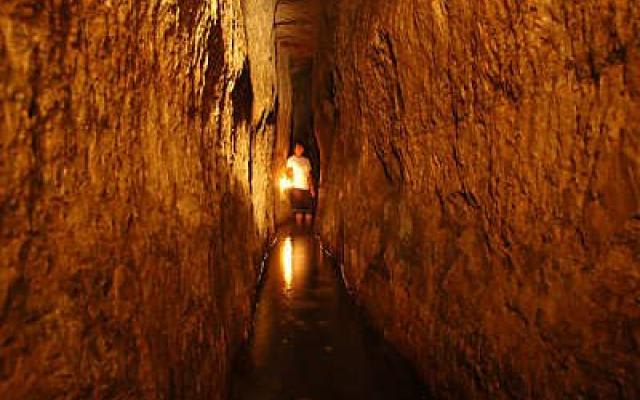
As afternoon arrives in Jerusalem, the sun gently infuses the city walls with their legendary golden color. Among a group of 40 English speakers on a lookout platform in the ancient City of David, it suddenly became clear to me that this is exactly where Jerusalem began and the Bible comes alive. True to the biblical verse harim saviv la, hills surround the holy city. The Mount of Olives stands to the east. The Armon Hanatziv ridge lies to the south. To the west is Mount Zion and to the north, the Temple Mount.
According to tradition, this is Mount Moriah, where Abraham was told to sacrifice Isaac and where all blessing flows from heaven.
The city’s history begins around 1000 BCE, when King David captured the Jebusite city south of the Temple Mount, established his capital and relocated the Ark of the Covenant. Over the next 500 years, Jerusalem expanded despite many political and religious upheavals until the Babylonians conquered the city and destroyed the First Temple in 586 BCE.
There was plenty more to explore on our three-hour tour, so we quickly descended toward Warren’s shaft, an underground tunnel hewn long before David’s arrival. In the Canaanite period (18th century BCE), this tunnel began as a protected passageway to Jerusalem’s original water source, the Gihon spring. This prolific artesian spring is named for its pulsing intervals.
Next we descended a winding metal staircase and proceeded into a tunnel. A few minutes later we could look into the natural underground shaft identified by British explorer Charles Warren in 1867. Our guide, Avinoam, asked us to stand in silence for a few moments to test whether or not we could hear the rush of spring water below — no such luck.
A few minutes later we reached the Spring House Excavation site, which opens to the Kidron Valley. Avinoam climbed over the remains of Jebusite towers and read aloud biblical verses describing King David’s instruction to “smite the Jebusite, go up the conduit and smite the lame and the blind” (Samuel II 5:7-8). The towers were so high that even a blind or lame guard could fight off an attack from lower ground.
Scholars theorize that David’s forces captured the city from this very point. One brave soul entered the Canaanite conduit and opened the city to the awaiting army.
Instead of heading outdoors, we descended another staircase. Cool, moist air blew on our faces and we could finally hear the rush of water below. Avinoam opened his Bible again and asked volunteers to re-enact the coronation of King Solomon, who was anointed with the Gihon’s water (Kings 11:38-39). Just as the text reads, Avinoam instructed us to clap and shout in response in Hebrew: Yechi HaMelech Shlomo (“Long live King Solomon”)!
Avinoam then recalled the Sukkot water libation in the Temple, which also relied on the Gihon. He produced a large brass dish from his bag, sent a volunteer to draw water, then symbolically poured the cool fluid over stone.
For the next 45 minutes we plunged ahead through the more than 500 yards of Hezekiah’s Water Tunnel, getting wet well above our knees. Avinoam explained that with the approach of the Assyrian King Sanheriv in 701 BCE, King Hezekiah diverted water from the Gihon to a pool between the southern walls of the city (Chronicles II 32:30). With our flashlights, we could clearly see chisel marks as well as the meeting place where two digging teams met underground.
Avinoam also showed us the spot where an inscription in ancient Hebrew was discovered in 1880: “… and with three more cubits to dig, there was heard a man’s voice calling to his fellow … the hewers hacked each toward the other, ax against ax, and the water flowed from the spring to the pool, a distance of 1,200 cubits …”
Exhilarated, we exited the dark tunnel. The music of guitarist Chaim David filled the bright air. He was on hand for Simchat Bet Hashoeva, the annual water drawing celebration.
As the sun dried us, we walked a short distance to an excavation area where just one week prior, archeologists discovered evidence of a Second Temple watering pool.
“Come back here in another year or two,” Avinoam said, “and who knows what you’ll find.”
Our last stop was Area G, where archeologists discovered the remains of the Jebusite terraced stone wall where David conquered the “Stronghold of Zion” (Samuel II 5:7). Now you can clearly see evidence of First Temple living quarters built atop the same wall. Scholars also discovered evidence of plumbing and furniture made of imported wood, suggesting these homes belonged to the city’s upper class.
Another astonishing find was a room containing 50 bullae, pieces of clay emblazoned with the seals of scribes and people of certain social standing. Avinoam passed around a replica, then discussed a discovery that reads in early Hebrew, “Gemariah, the son of Shaphan.” Presumably this is the same royal scribe mentioned in Jeremiah 36:10.
The bullae collection may now be all that remains of an archive of royal documents burned during the destruction of the First Temple.
Amid these stones, our ancestors wrote Ecclesiastes, Song of Songs, Jeremiah, Lamentations, Kings and other chapters of the Bible. And today we return to witness the realization of Jeremiah’s prophecy.
“With the happiness of Bet Hashoevah and the music of Chaim David,” Avinoam said, “you already hear the sounds of gladness returning to Jerusalem.”
When you go:
For more information, photos, an original musical composition, a virtual tour, timeline, news updates on archaeological discoveries and more, visit www.cityofdavid.org.il
Frequent contributor Lisa Alcalay Klug has written for the New York Times, Forward and many other publications. She is the author of the forthcoming Cool Jew: The Ultimate Guide for Every Member of the Tribe. To learn more visit www.lisaklug.com
The words of this author reflect his/her own opinions and do not necessarily represent the official position of the Orthodox Union.
